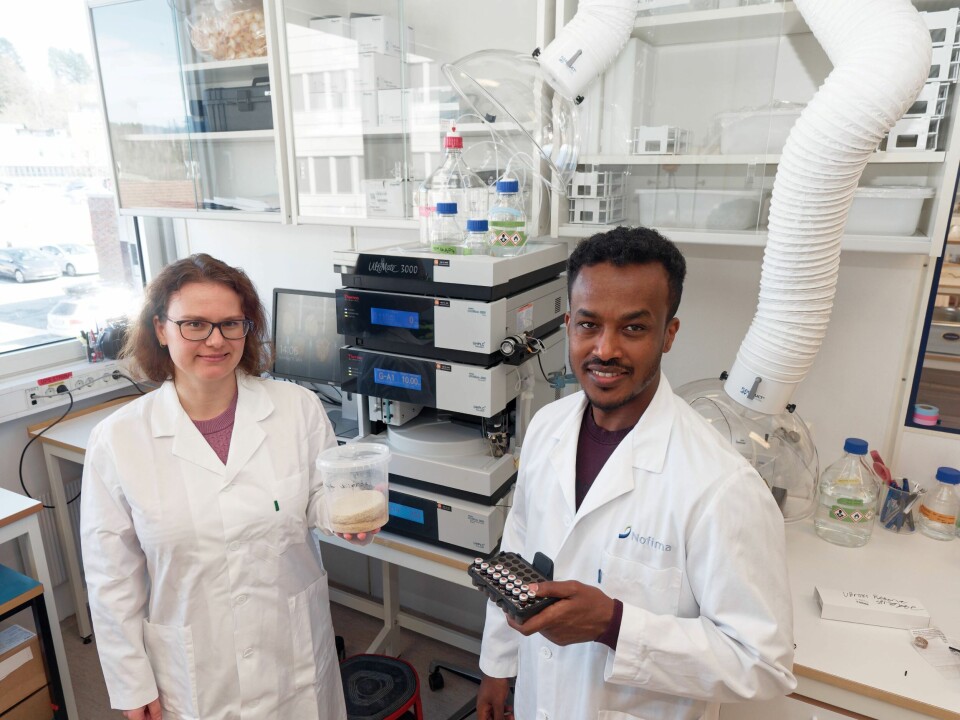THIS CONTENT IS BROUGHT TO YOU BY Nofima The Norwegian Institute of Food, Fisheries and Aquaculture Research - read more

Chicken leftovers can help with both diabetes and high blood pressure
Once the meat is eaten, beneficial compounds are found in the leftover bones.
Once the slaughterhouse sent out the choice cuts, Liudmila Sorokina takes care of the leftovers. She researches chicken processing by-products at Nofima.
Cuts proteins
Or, more precisely, she is conducting research on the beneficial substances found in chicken by-products. These are what remain of the chicken after both the butcher and the machines have extracted everything suitable for human consumption.
"Our aim is to utilise the protein-rich leftovers," Sorokina says.
She uses a process called enzymatic protein hydrolysis. Enzymes are natural substances found in all living organisms. They ensure that other substances are either assembled or split up. In this case, enzymes and water are used to split proteins.
“We mix the raw material with water and specialised enzymes. When we're done, there are bones at the bottom. At the top, there is fat. What we're interested in is what's floating in the middle. There, the enzymes have cut up proteins into shorter parts: peptides,” she explains.

Blood pressure
There are countless different peptides, each potentially having distinct functions in the body.
“We've removed the water and extracted a powder containing many different peptides. When we change the temperature, time, or enzymes we add, we can extract completely different products from the same raw material," Sorokina says.
She explains that her project has produced 60 different hydrolysates. The researchers are trying to identify which ones have the impact they want.
The amounts are too small to extract a single peptide. Therefore, it is important to find the right group. A group of peptides enough in amount to be separated out and developed as a product, and at the same time exactly the group of peptides that works best.
“In the first project, we've developed a peptide that can regulate blood pressure. We have had a mixture of all kinds of peptides with different lengths, which we have grouped according to size,” says Sorokina.

Dietary supplement
She has used two methods that find out how different substances are composed: chromatography and mass spectrometry.
“Using these methods, we can determine not only the health effects but also the structure of the molecules,” says Sileshi G. Wubshet.
He is a senior researcher at Nofima and has supervised Liudmila Sorokina.
Understanding the molecular structure is crucial for turning the research into a final product, which in this case will be a dietary supplement that can help with both high blood sugar and high blood pressure.
Artificial stomach and intestines
Liudmila Sorokina has also looked at how the peptides she discovered manage to survive the harsh conditions of the stomach and intestines of humans.
“Peptides are food. We humans are very good at turning what we eat into energy. The danger is that the peptides get digested in the stomach and lose the important health-promoting effects. The peptides should not only survive in the stomach, they should also cross the other biological barriers and rich where they have an effect in your body,” says Sileshi G. Wubshet.
“What we've found is that they're stable in stomach and intestinal conditions,” says Sorokina.
For such experiments, Nofima has its own artificial gastrointestinal model. It offers the same conditions as the digestive system of a human being.
References:
Sorokina et al. 'Low Molecular Weight Peptide Fraction from Poultry Byproduct Hydrolysate Features Dual ACE-1 and DPP4 Inhibition', ACS Food Science & Technology, 2023. DOI: 10.1021/acsfoodscitech.3c00417 (Abstract)
Sorokina et al. Multivariate correlation of infrared fingerprints and molecular weight distributions with bioactivity of poultry by-product protein hydrolysates, Journal of Functional Foods, vol. 95, 2022. DOI: 10.1016/j.jff.2022.105170

This content is paid for and presented by Nofima The Norwegian Institute of Food, Fisheries and Aquaculture Research
This content is created by Nofima's communication staff, who use this platform to communicate science and share results from research with the public. Nofima is one of more than 80 owners of ScienceNorway.no. Read more here.
More content from Nofima:
-
Red algae grown in wastewater from fish-farming facilities could become sustainable salmon feed
-
Pumpkins are good for more than just Halloween decorations
-
This is how temperature affects a salmon's health and growth
-
Study: Omega-3 and zinc is a powerful duo for salmon
-
Fish may turn yellow if frozen too fresh
-
Is it better if food is packaged in plastic or paperboard?





































